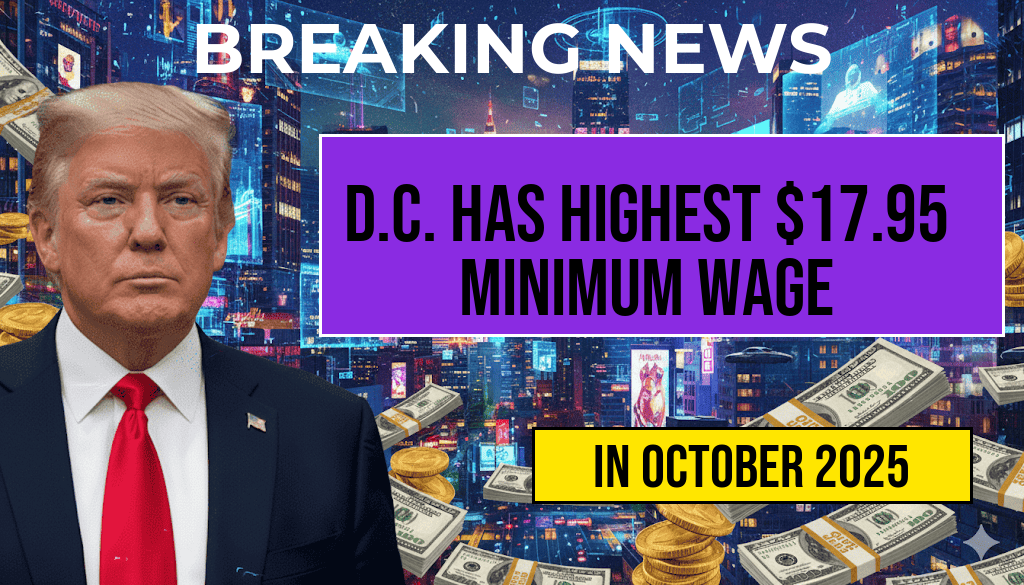Washington D.C. has established itself as the U.S. city with the highest minimum wage, setting the rate at $17.95 per hour as of July 2023. This marks a significant increase from previous years and reflects the district’s ongoing efforts to address economic disparities and improve living standards for low-wage workers. The new rate surpasses the national average and outpaces neighboring states, positioning D.C. as a leader in wage policy reform. The move has garnered attention from policymakers, labor advocates, and business owners alike, sparking discussions about the balance between fair compensation and economic sustainability. With the federal minimum wage remaining at $7.25 since 2009, D.C.’s decision underscores regional variation in labor standards and highlights the district’s commitment to progressive economic policies. As inflation continues to impact households across the country, the district’s wage increase aims to provide meaningful relief for its lowest-paid workers while setting a potential precedent for other jurisdictions.
Background on Washington D.C.’s Wage Policies
Washington D.C. has historically been at the forefront of implementing higher minimum wages compared to federal standards. The district’s minimum wage rate is adjusted annually based on inflation and cost of living metrics, which are determined by the D.C. Department of Employment Services. The latest increase, effective July 1, 2023, was approved after extensive negotiations among city officials, labor groups, and business associations.
Legal Framework and Policy Drivers
- Minimum Wage Act of 2019: Legislation passed to incrementally raise the minimum wage to $15.00 by 2025, with annual adjustments thereafter.
- Living Wage Ordinance: Policies that promote wages sufficient to cover basic living expenses, including housing, transportation, and healthcare.
- Economic Justice Initiatives: Programs aimed at reducing income inequality and supporting underserved communities.
Impacts on Workers and Employers
| Aspect | Details |
|---|---|
| Worker Benefits | Increased earnings for approximately 120,000 workers, including retail, hospitality, and service sector employees. |
| Cost of Living | Higher wages aim to offset rising housing and transportation costs, which have increased by over 10% in the past year. |
| Business Response | Some small businesses express concerns about increased labor costs, while others see the wage hike as beneficial for employee retention. |
| Employment Trends | Early data suggests stable employment levels, though long-term impacts remain under observation. |
Regional Comparisons and Broader Context
Compared to other U.S. cities, Washington D.C.’s minimum wage stands out notably. For example, California’s minimum wage is $15.50 per hour, but varies by employer size, and New York State’s minimum is $15.00. Many Southern states maintain lower rates, often below $10.00 per hour, reflecting differing policy priorities and economic conditions.
The district’s approach aligns with broader progressive trends across several municipalities that aim to set wages above federal levels. According to the Wikipedia entry on minimum wages in the U.S., states and cities are increasingly adopting regional standards tailored to local economic realities. These policies often face pushback from business groups concerned about competitiveness, but supporters argue they are essential for reducing poverty and promoting shared prosperity.
Looking Ahead: Policy and Economic Outlook
As Washington D.C. continues to adjust its minimum wage, attention turns to the long-term effects on the local economy. City officials emphasize that the wage hike is part of a broader strategy to foster economic inclusion and stabilize living conditions for low-income residents. Meanwhile, debates persist regarding the potential for wage increases to influence employment opportunities, particularly among younger and less-experienced workers.
Economic analysts suggest that, if managed carefully, the district’s progressive wage policies could serve as a model for other jurisdictions seeking to balance growth with equity. Monitoring employment data and cost-of-living trends in the coming months will be crucial to understanding the full impact of the latest adjustment.
Resources and Further Reading
- Washington D.C. Department of Employment Services – Minimum Wage
- Wikipedia – Minimum Wage in the United States
- Forbes – How Washington D.C. Set the Highest Minimum Wage
Frequently Asked Questions
What is the current minimum wage in Washington D.C.?
The minimum wage in Washington D.C. is currently $17.95 per hour, making it the highest in the country.
When did Washington D.C. implement this highest minimum wage?
Washington D.C. adopted the highest minimum wage policy to ensure better earning opportunities for workers, with the new rate taking effect in recent updates.
How does Washington D.C.’s minimum wage compare to other states?
Washington D.C.’s minimum wage of $17.95 per hour surpasses that of other states, making it the highest in the nation.
Are there any exceptions or special provisions related to the minimum wage in D.C.?
Yes, certain exceptions may apply based on worker classification or industry standards. It’s advisable to consult local regulations for specific details.
What are the benefits of having the highest minimum wage?
The benefits include improved living standards for workers, increased consumer spending, and a potential boost to the local economy.

Leave a Reply